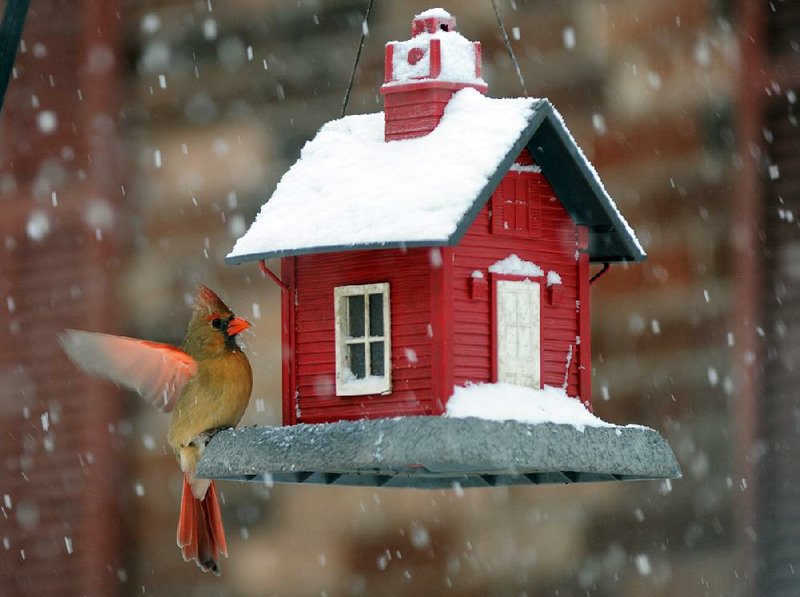There’s nothing better than watching songbirds at feeders during winter’s dreary months.
Cardinals in ruby red coats, woodpeckers in black and white tuxedos and bluebirds in royal finery brighten the grayest day.
“The frequent visitors to our feeders quickly become old friends - the same birds come every day, all day,” says Shirley Devan, outgoing president of the Williamsburg Bird Club in southeastern Virginia.
“I quickly learn who likes to eat seeds on the ground, who likes the seed feeders, who likes the suet feeders. Birds always surprise me. The red-bellied woodpecker likes the seed feeder more than the suet. The brown thrasher prefers suet. ‘My’ hermit thrush usually just sips water. I have a pair of downy woodpeckers - male and female. I like to think they nest in my neighborhood in spring and summer.”
Bird feeders for a home-based habitat are a personal choice.
Williamsburg birder Martha WrenBriggs says commercial feeders aren’t necessary because birds are tree or ground feeders, and each type eats bread and seeds tossed on the ground, or put in a flat dish. Fresh water is important even in winter and is best provided in a shallow dish, such as a large flat saucer used under large planters, because birds dislike a deep bird bath, she advises.
“Use your imagination to feed your tree-dining friends,” she says.
“The easiest way to serve fat trimmings from meats, suet or a peanut butter and cornmeal mixture is to simply rub it on the bark of a tree. Tree feeders will shimmy down the tree and peck away at the delicious treat.
“Wrens are curious birds. Place an almost empty peanut butter jar on the ground, and wrens will go in and out, taking a nibble each time.”
If you opt for traditional feeders, squirrels and raccoons could well raid your seed supply, so baffle deterrents are your best friend. If blackbirds swarm your surroundings, caged feeders help keep bully birds and squirrels at bay; when you choose caged feeders, make sure the cages are large enough to prevent unwanted critters from reaching in to grab goodies.
Even the posts that support feeders are important parts of the pastime. Wrought-iron poles with hooks for hanging feeders are attractive, but often they lean and fall in soft, wet soil. Feeders hung on trees are highly susceptible to predators taking advantage of the situation.
If you’re looking for an extra-sturdy feeding station, here’s one I recently created for my feathered friends.
Bird-feeding station
1 square treated post, 4-by-4, 10 feet long
1 bag, quick-set concrete
Water
Level
Raccoon/squirrel baffle with 4-inch square opening
4 hooks, each about 12 inches long (consider vinyl-coated hooks, not just painted versions, for durability); choose hangers that set out far enough to accommodate width of feeders
Decorative treated cap for post top
Post hole digger
4 bird feeders
Use a post-hole digger to create a hole about 24 inches deep. Place treated post in hole, pour in concrete mixed with water according to directions on bag.
As concrete sets, adjust post and use level to ensure the post is straight on all sides.
Allow post to set a couple of days before installing baffle and attaching hangers (use long screws for stability). Place decorative cap on post top; fill and hang feeders.
FEEDERS AND FILLERS
For feeders on the four hooks, consider a caged suet feeder, Duncraft caged peanut feeder and two Droll Yankees caged domed feeders with large tubes so you don’t have to fill them so often. Plastic domes on feeders help shield them from rain; you may want to consider taking in feeders during prolonged, heavy rains to prevent costly seed from molding.
For seeds, sunflower will get you tons of beautiful birds, but it may also attract blackbirds and obnoxious fish crows that tend to live near waterways. Look for special blends like one made by Cole’s that include sunflower meats, fruits and assorted nuts. Cole’s seeds (coleswildbird.com) are sold at specialty wildlife stores and garden centers nationwide.
In addition to the feeding station, consider specialty feeders such as a finch feeder with thistle seed, bluebird feeder with dried mealworms and platform feeders (composite wood feeders are awesome!) with safflower seed, which squirrels and nuisance birds tend to leave alone. Look for feeders that are easy to clean, such as the Droll Yankees feeders, which have a metal rod that you pull to remove the ports for easy cleaning. Feeders should routinely be cleanedwith a splash of bleach added to soap and water, then thoroughly rinsed and dried before refilling.
No matter how many or what style bird feeders you choose to use, there is one all-important aspect to remember - enjoy the sights and sounds of your feathered friends. They will probably stick around and nest in your yard, turning your environment into a healthy, happy habitat.
Suet recipe
1 cup smooth peanut butter
1 cup vegetable shortening
1 cup white flour, not self rising
3 cups yellow cornmeal, not self-rising
Mix ingredients together thoroughly and place in a suet log (small log with holes drilled in it) or simply smear the paste on the trunk of a tree, branch, post or other solid object where birds can easily find and reach it. Store unused suet in closed container in refrigerator until needed.
Keep it simple: Using plain beef suet is great for birds - squirrels leave it alone, it’s cheap and all the birds love it!
Recipe from National Audubon Society (audubon.org) and Cornell Lab of Ornithology (birds.cornell.edu)
HomeStyle, Pages 35 on 02/01/2014
